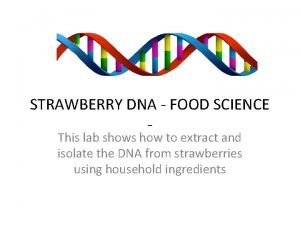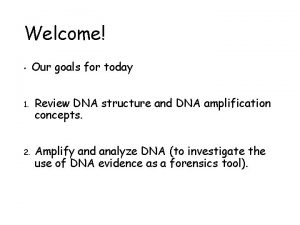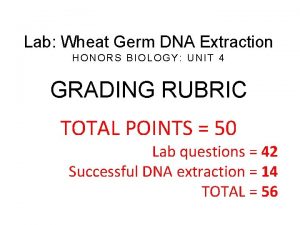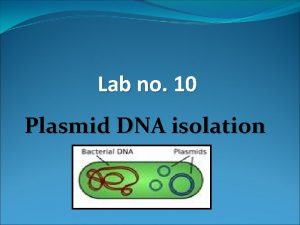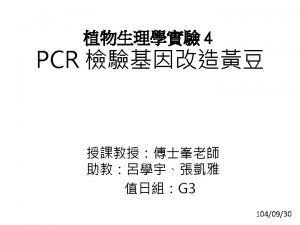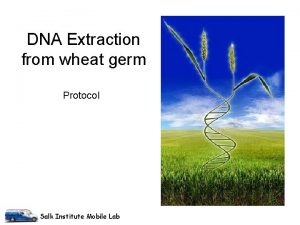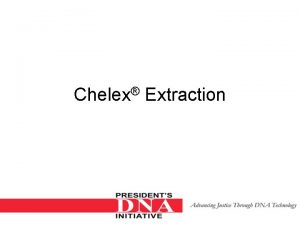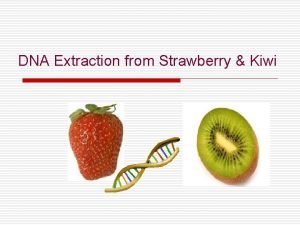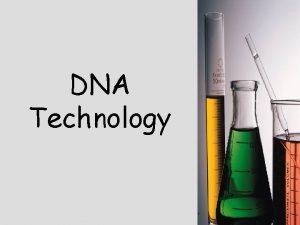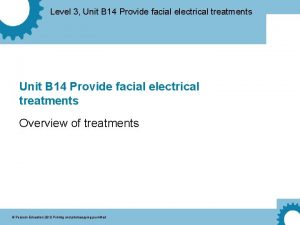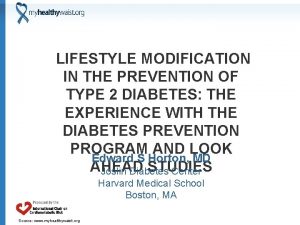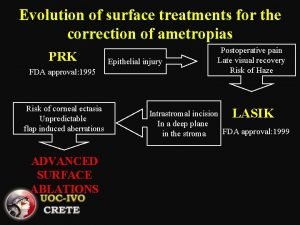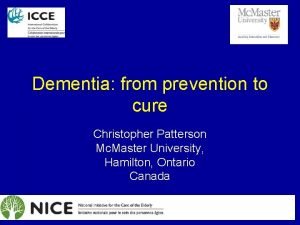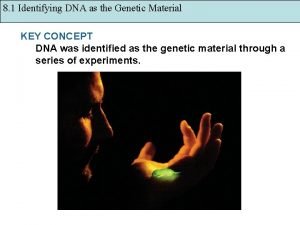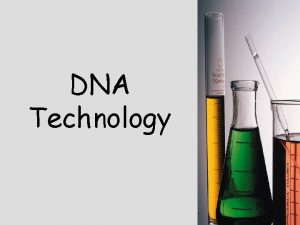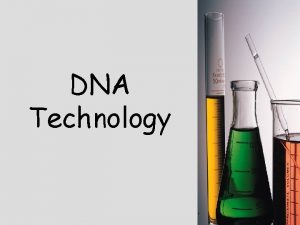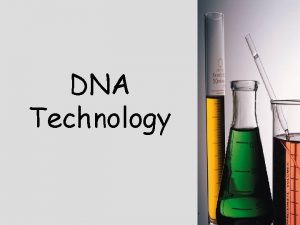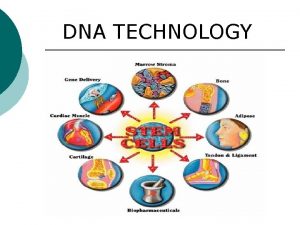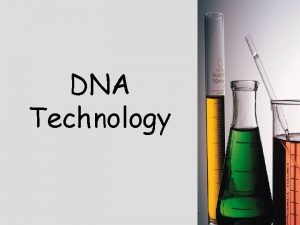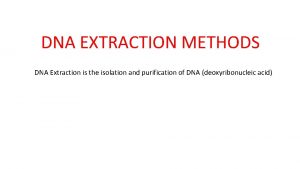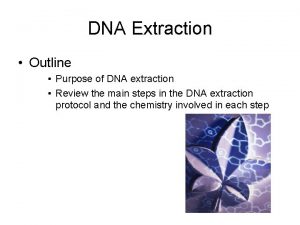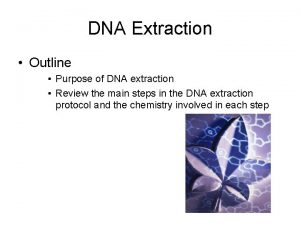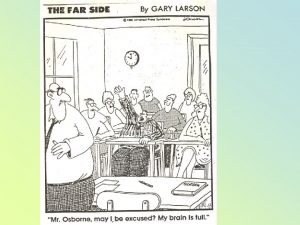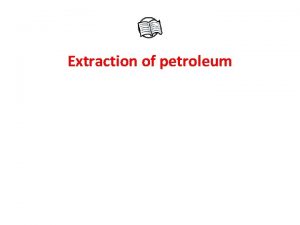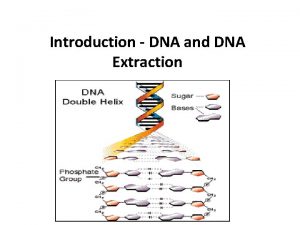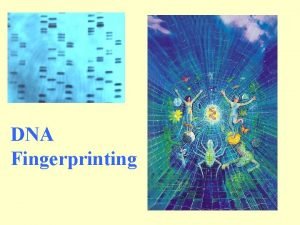DNA Technology 1 DNA Extraction Chemical treatments cause































- Slides: 31

DNA Technology 1

DNA Extraction • Chemical treatments cause cells and nuclei to burst • The DNA is inherently sticky, sticky and can be pulled out of the mixture • This is called “spooling” DNA 2

“Spooled” DNA 3

Cutting DNA • Restriction enzymes cut DNA at specific sequences • Useful to divide DNA into manageable fragments 4

Electrophoresis • DNA can be separated based on size and charge • The phosphate groups are negatively charged • DNA is placed in a gel and electricity is run through 5

Electrophoresis • Negative DNA moves toward the positive end • Smaller fragments move farther and faster 6

Electrophoresis 7

Steps in DNA Sequencing • Many copies of a single strand of DNA are placed in a test tube • DNA polymerase is added • A mixture of nucleotides is added some of which have dye molecules attached • Each base (A, T, C, G) has a different color dye 8

Steps in DNA Sequencing • By chance, some dyed nucleotides & some regular ones are added • Dye molecules are large and stop the chain from growing 9

DNA Sequencing • The result is DNA fragments of multiple sizes with colors that can be identified 10

DNA Sequencing • After the gel separates the resulting fragments by size, we 'read' the sequence from bottom to top. 11

Copying DNA • Polymerase Chain Reaction • Also called PCR • A method of making many copies of a piece of DNA 12

Steps in Copying DNA • A DNA molecule is placed in a small test tube • DNA polymerase that can work at high temps is added 13

Steps in Copying DNA • The DNA is heated to separate the two strands • Primers, Primers short pieces of DNA complementary to the ends of the molecule to be copied, are added 14

Copying DNA • The tube is cooled, and DNA polymerase adds new bases to the separated strands 15

PCR Large amounts of DNA can be made from a small starting sample 16

Cloning • Clone a member of a group of genetically identical cells • May be produced by asexual reproduction (mitosis) 17

Cloning organisms • A body cell from one organism and an egg cell from another are fused • The resulting cell divides like a normal embryo 18

Cloning “Dolly” 19

Human Genome Project 20

Human Genome Project • Started in 1990 • Research effort to sequence all of our DNA (46 chromosomes) • Over 3. 3 billion nucleotides • Mapping every gene location (loci) • Conducted by scientists around the world 21

HGP Insights • Only 2% of human genome codes for proteins (exons) • Other 98% (introns) are non-coding • Only about 20, 000 to 25, 000 genes (expected 100, 000) • Proteome – organism’s complete set of proteins • About 8 million single nucleotide polymorphisms (SNP) – places where humans differ by a single nucleotide • About ½ of genome comes from transposons (pieces of DNA that move to different locations on chromosomes) 22

Benefits of Human Genome Project • Improvements in medical prevention of disease, gene therapies, diagnosis techniques … • Production of useful protein products for use in medicine, agriculture, bioremediation and pharmaceutical industries. • Improved bioinformatics – using computers to help in DNA sequencing … 23

Benefits of Genetic Engineering 24

Biotechnology • The use of gene science to create new products from plants and animals 25

Biotechnology Provides: • Improved food products • Medical advances • An enhanced environment 26

Herbicide Resistant Crops + CP 4 EPSPS = Roundup gene Ready • • Soybeans: Corn: Cotton: Canola: Ready Roundup Ready, Liberty Link BXN, Roundup Ready Liberty Link, Roundup 27

Biotechnology Breakthroughs • Insulin (1982) – First commercial biotech product – Reliable, inexpensive source of insulin • Rice – Enriched with beta-carotene and iron • Bananas – Containing edible hepatitis vaccine 28

Biotechnology Breakthroughs • Potatoes with higher solid content • Garlic that lowers cholesterol • Fruits and vegetables that reduce risks of cancer and heart disease 29

Environmental Benefits • Reduced pesticide use • Lower energy requirements • Cleaner water • Less soil erosion 30

31
 Strawberry dna extraction materials
Strawberry dna extraction materials Dna extraction
Dna extraction Wheat germ dna factory
Wheat germ dna factory Dna extraction
Dna extraction Difference between dna and rna extraction
Difference between dna and rna extraction Dna extraction
Dna extraction Dna extraction from wheat germ
Dna extraction from wheat germ Chelex dna extraction advantages and disadvantages
Chelex dna extraction advantages and disadvantages Kiwi dna extraction
Kiwi dna extraction Dna extraction from kiwi fruit
Dna extraction from kiwi fruit Ter death certificate
Ter death certificate Greylag goose egg-retrieval behavior
Greylag goose egg-retrieval behavior Proximate causes of behavior
Proximate causes of behavior Kinesis and taxis
Kinesis and taxis Treatments for acute renal failure
Treatments for acute renal failure Level 3 electrical facial
Level 3 electrical facial Multi element design
Multi element design Hiv treatments
Hiv treatments Diabetes treatments
Diabetes treatments Advanced surface treatments
Advanced surface treatments Insomnia treatments
Insomnia treatments Dementia treatments and interventions near patterson
Dementia treatments and interventions near patterson Replication fork
Replication fork Bioflix activity dna replication dna replication diagram
Bioflix activity dna replication dna replication diagram Coding dna and non coding dna
Coding dna and non coding dna The principal enzyme involved in dna replication is
The principal enzyme involved in dna replication is Dna rna protein synthesis homework #2 dna replication
Dna rna protein synthesis homework #2 dna replication What are the chemical substances of dna
What are the chemical substances of dna Section 2 classifying chemical reactions worksheet answers
Section 2 classifying chemical reactions worksheet answers Empirical formula pogil
Empirical formula pogil Section 2 classifying chemical reactions worksheet answers
Section 2 classifying chemical reactions worksheet answers Section 1 chemical changes
Section 1 chemical changes
